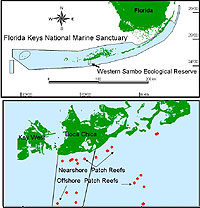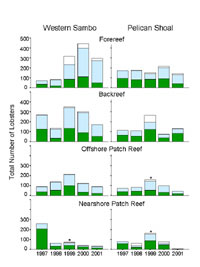 | |||||||||
|
|
|
|
|

Every year from 1997 through 2001, the scientists conducted lobster surveys within each four different habitat types found within the reserve and reference area. Samples were taken in July (the end of the closed fishing season) and in September (following the first month of the fishing season). The sampling schedule was chosen to fall near the end of the reproductive season to minimize differences in lobster abundance related to migration following the reproductive period. Scientists completed 229 of 240 scheduled surveys from 1997 to 2001, and counted a total of 3569 lobsters a Western Sambo reserve and 2366 lobsters at Pelican Shoal. After five years of monitoring, scientists observed that legal-sized lobsters were significantly larger in the protected area than in the exploited area. In addition, scientists observed a steady increase in the numbers of large males and adult females inside the reserve.
The greater number of large male and females found inside the reserve is also likely increasing the success of lobster reproduction. The number of eggs produced by lobster increases exponentially with size so the larger lobsters are producing significantly more eggs than their counterparts outside the reserve. There are also indications that lobsters are “spilling over” from the Western Sambo reserve into adjacent fished areas. The appearance of a small number of very large males at Pelican Shoal several years after establishment of Western Sambo reserve is an indication that this may be occurring. Ongoing mark-recapture and sonic tagging studies will help to determine whether fished areas are also benefiting from the reserve. This story is taken from excerpts from a study published by Carrollyn Cox and John H. Hunt with permission from the authors. The full study report is available in the journal Marine Ecology Progress Series (2005), volume 294, pages 227-239. The scientists are with the Florida Fish and Wildlife Conservation Commission, Fish and Wildlife Research Institute, South Florida Regional Laboratory, 2796 Overseas Highway, Suite 119, Marathon, Florida 33050. |
|
||||
|
|||||||||




